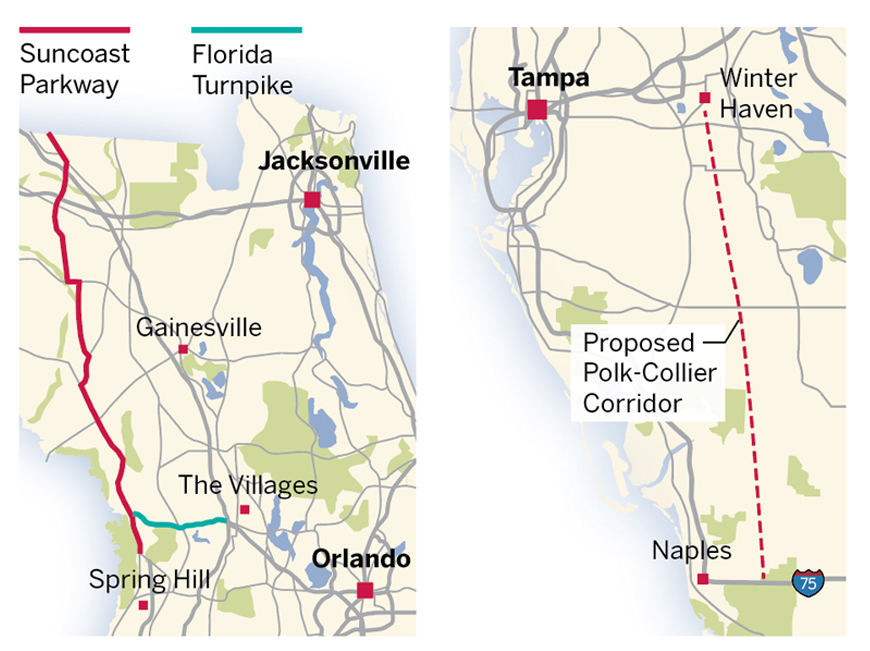- November 23, 2024
-
-
Loading

Loading

Give Florida Senate President Bill Galvano, R-Bradenton, credit for thinking about Florida’s future needs. We need more state lawmakers who think that way rather than what’s the best way to get re-elected.
If you missed it, last week at the annual Associated Press’ pre-legislative gaggle with reporters, Galvano told reporters he has directed Senate Infrastructure Chairman Tom Lee to begin work on the potential costs and a timeline to extend two major highways and build a new “multi-use” transportation corridor from Polk County (Lakeland) to Collier County (Naples).
Galvano said he wants to extend the Suncoast Parkway toll highway to Georgia, creating a tollway that extends from Tampa to Georgia; and to extend the Florida Turnpike from its northern endpoint at Wildwood and Interstate 75 to connect with the Suncoast Parkway. (See maps).

Galvano’s rationale is twofold: All of these tollways would provide additional hurricane evacuation routes and “to have access to our rural communities and provide multi-purpose rights-of-ways so that prosperity can return” to the rural areas.
Galvano proposed to pay for these highways via the state taking on new debt through the sale of long-term general obligation bonds. That is about 425 miles of new four-lane highway. And with four-lane highway costs roughly $5 million per mile — not including buying the land and right-of-way, just the concrete alone will be in the $2.12 billion range.
But figure at least double that. You know how it goes: These days everything takes twice as much and twice as long as you think.
Can Florida afford the additional debt? If you read the Florida Department of Transportation’s annual debt report, Florida has plenty of cash coming in through gas taxes, aviation fuel taxes, motor vehicle fees, rental car surcharges and existing tolls to fund additional borrowing. Evidence:
State laws require that DOTs borrowing cannot exceed 20% of state and federal funds available for transportation. Based on DOT’s 2017 debt report, over the next five years, DOT’s debt load as a percentage of available of cash will range from 9.8% to a high of 14.3% in fiscal 2021-22.
The cash flow is there.
Not only that, there are other financing options. Why not privatize the toll roads?
Whether lawmakers have the will for these three projects will be another matter.
Predictably, Galvano’s proposal is drawing rebukes.
You’ll hear criticisms that extending the Suncoast Parkway will destroy the rural, pristine nature of some of Florida’s least populated, Old-Florida counties. We don’t need more roads going through sparsely populated and little traveled areas, the argument goes; we need more roads, expressways and other transportation modes in Florida’s increasingly congested urban areas.
What’s more, those opposed to building highways instinctively protest that new tollways will encourage more sprawl — more people, more development. Indeed, longtime Florida economist Hank Fishkind has said for decades that experience has shown whenever anyone builds a new road in Florida, development most assuredly follows. Just take the State Road 417 beltway around the southern side of Orlando. You’ll see the extraordinary rise of what is known as Medical City — a new city of hospitals and residences — in what a few years ago was nothing but land.
But again, give Galvano credit for looking ahead. The University of Florida Bureau of Business and Economic Research is projecting Florida will add at least 240,000 more people a year for each of the next 25 years — 6 million people on top of the 21 million already here. And you can bet most of those new residents will migrate toward the coasts, increasing the densities and traffic in the state’s major and secondary urban areas.
As long as Florida remains a state with no personal income tax and has no estate tax, Florida will continue to add population. And if you study the population trends over the past 50 years, the majority of those new residents go to the existing urban areas. Miami-Dade, in spite of how crowded it already is, consistently adds more people in a year than move to Sarasota and Manatee County combined.
Given that projected growth, why not prepare for it instead of attempting to catch up? We see each day in Sarasota and Manatee counties the effects of road systems not keeping up with growth.
So Galvano’s thinking is on target:
Imagine 6 million more people trying to evacuate with Florida’s existing population and existing interstate network.
Florida has a long history of always trying to play catch-up with its highway and transportation needs. And it never catches up.
Perhaps Galvano’s leadership can change the Legislature’s thinking. To be sure, legislators seldom think long-term and are prone to respond to the crises and controversial issues of the moment. But now is as good of a time as any for lawmakers to think beyond the here and now.
There’s no fiscal crisis. Florida’s economy is strong. And it’s not an election year. It’s a perfect time to look into the future and make sure Florida is prepared for what’s to come.